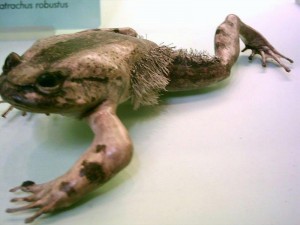The Horror Frog
August 31st, 2010

“Amphibian horror” isn’t a movie genre, but on this evidence perhaps it should be. Harvard biologists have described a bizarre, hairy frog with cat-like extendable claws.
Trichobatrachus robustus actively breaks its own bones to produce claws that puncture their way out of the frog’s toe pads, probably when it is threatened.
David Blackburn and colleagues at Harvard University’s Museum of Comparative Zoology, think the gruesome behaviour is a defence mechanism.
The researchers say there are salamanders that force their ribs through their skin to produce protective barbs on demand, but nothing quite like this mechanism has been seen before.
The feature is also found in nine of the 11 frogs belonging to the Astylosternus genus, most of which live in Cameroon.
Instant weapon
“Some other frogs have bony spines that project from their wrist, but in those species it appears that the bones grow through the skin rather than pierce it when needed for defence,” says Blackburn.
At rest, the claws of T. robustus, found on the hind feet only, are nestled inside a mass of connective tissue. A chunk of collagen forms a bond between the claw’s sharp point and a small piece of bone at the tip of the frog’s toe.
The other end of the claw is connected to a muscle. Blackburn and his colleagues believe that when the animal is attacked, it contracts this muscle, which pulls the claw downwards. The sharp point then breaks away from the bony tip and cuts through the toe pad, emerging on the underside.
Hirsute horror
The end result may look like a cat’s claw, but the breaking and cutting mechanism is very different and unique among vertebrates. Also unique is the fact that the claw is just bone and does not have an outer coating of keratin like other claws do.
Because Blackburn has only studied dead specimens, he says he does not know what happens when the claw retracts – or even how it retracts. It does not appear to have a muscle to pull it back inside so the team think it may passively slide back into the toe pad when its muscle relaxes.
“Being amphibians, it would not be surprising if some parts of the wound heal and the tissue is regenerated,” says Blackburn.
Males of the species, which grows to about 11 centimetres, also produce long hair-like strands of skin and arteries when they breed (see image). It is thought that the “hairs” allow them to take in more oxygen through their skin while they take care of their brood.
Spiky snack
In Cameroon, they are roasted and eaten. Hunters use long spears and machetes to kill the frogs, apparently to avoid being hurt by their claws.
“This is an incredible story,” says Ian Stephen, curator of herpetology at the Zoological Society of London, UK. “Some frogs grow spines on their thumbs during breeding season, but this is entirely different.”
“For me, it highlights the need for a lot more research on amphibians especially in light of the threat of mass extinctions,” he adds.
The existence of frogs with erectile claws like cats was first described by Belgian zoologist George Boulenger in 1900 in frogs found in the French Congo, now the Republic of Congo.

